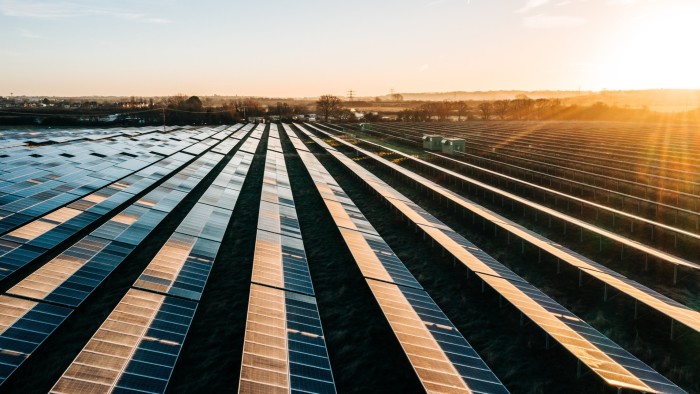Call for entries: Europe’s Climate Leaders 2024

Simply sign up to the European companies myFT Digest -- delivered directly to your inbox.
Addressing her annual state of the union speech to the European parliament last month, European Commission president Ursula von der Leyen praised businesses’ efforts to cut greenhouse gas (GHG) emissions. “Europe’s industry is. . . proving that modernisation and decarbonisation can go hand in hand,” she declared.
National interests, however, mean that Europe’s industry does not always move as swiftly as EU policymakers would like. In March, for example, Germany pushed successfully to shield carmakers from a 2035 ban on the sale of combustion engines, by securing an exemption for vehicles that run on supposedly low-carbon e-fuels.
Such tussles would simply be the routine stuff of politics — but for the fact that GHG-driven climate change is, scientists say, making Europe more prone to extreme weather, with catastrophic consequences. After another summer of heatwaves, wildfires and floods, last month was the continent’s — and the world’s — warmest September on record.
So which European companies are moving fastest on decarbonisation? To help answer this question, the Financial Times and Statista, the German data provider, publish an annual list of those that have achieved the greatest reduction in their GHG emissions intensity. The entry period for businesses that think they may be eligible for next year’s edition, the fourth, has just begun.
While the 2024 Europe’s Climate Leaders list will highlight the businesses whose Scope 1 and 2 GHG emissions intensity — that is, emissions relative to revenue — fell the most between 2017 and 2022, it will also draw on other metrics.
Scope 1 and 2 emissions, which arise respectively from a company’s own operations and from the energy it purchases, are relatively easy to measure. Far harder to account for, though in many cases far larger, are so-called Scope 3 emissions, which occur elsewhere in the value chain; businesses’ transparency on these, together with their performance as assessed by climate standard-setters CDP and SBTi, and their progress on absolute emissions, will help determine the final list, which will be published in an FT print supplement in spring 2024, as well as online at ft.com.
All European companies with a minimum revenue of €40mn or £36mn in 2022 are eligible for consideration (see below for the full list of eligible countries). In order to participate, we invite you to fill out a short questionnaire about your company’s GHG emissions for all available years between 2017 and 2022, and its revenue over the same period (or, for banks, the net interest income). We also ask you to send us a data verification form, which needs to be downloaded and signed.
Eligibility for the list will be determined by the compound annual reduction rate (CARR) of the emissions intensity. Potential candidates will be contacted by Statista or can put their name forward at the Statista website, which also has more information about the methodology, conditions of participation and useful contacts.
Why should my company participate?
▩ NEW BUSINESS OPPORTUNITIES
Inclusion in the Europe’s Climate Leaders list will be a visible and public acknowledgment of your company’s environmental performance that extends far beyond your specific industry and country. It will also generate attention for your business on the part of potential partners, customers, employees and investors around the world.
▩ EFFECTIVE MEDIA COVERAGE
The full list will be published in a special report, a supplement within a weekday edition of the FT newspaper and on FT.com. The report will also include articles by FT journalists on interesting companies, sectors and trends within the sustainability field.
▩ REPUTATION
All companies that make it on to the list may use the award logo for marketing purposes¹.
▩ ACCESS TO MORE THAN 1M FACTS
All participants that provide us with data on their GHG emissions and revenue will receive a free two-week Statista corporate subscription trial — irrespective of whether or not they are among the companies listed in the ranking.
¹ The use of the label and the word-and-image logo “Europe’s Climate Leaders 2024” for marketing purposes is subject to a one-off payment of a licence fee. Inclusion in the ranking, however, is completely free of charge.
Who is eligible?
To be considered for inclusion in the list your company must meet the following criteria:
Revenue of at least €40mn/£36mn generated in 2022¹
Must be headquartered in Europe²
Must report emissions data independently
In case a CDP rating is available, the score must be at least B-³
¹ Non-euro countries: currency value equivalent as of 31/12/2022.
² Eligible to participate are all companies from these countries: Austria, Belgium, Bulgaria, Bosnia and Herzegovina, Croatia, Cyprus, Czech Republic, Denmark, Estonia, Finland, France, Germany, Greece, Hungary, Iceland, Ireland, Italy, Latvia, Lithuania, Luxembourg, Malta, Monaco, Netherlands, Norway, Poland, Portugal, Romania, Slovakia, Slovenia, Spain, Sweden, Switzerland, UK.
³ For companies with emissions of over 2mn tonnes CO₂-equivalent, a CDP rating of at least A- is mandatory.
How do I register?
STEP ONE: ONLINE REGISTRATION
Please register with Statista online here by December 22 2023. Alternatively, you can download the form and, upon completion, send it to climate-europe@statista.com or to the postal address given.
STEP TWO: DATA VERIFICATION
Your emissions and revenue data need to be verified. The necessary form must be downloaded, signed in person by a managing director or a member of your executive committee (chief executive or chief sustainability officer), and then sent to Statista by email, fax or mail. All necessary address details can be found on the form.
Contact details
Should you have any additional questions or would otherwise like to contact us, please email climate-europe@statista.com
Comments